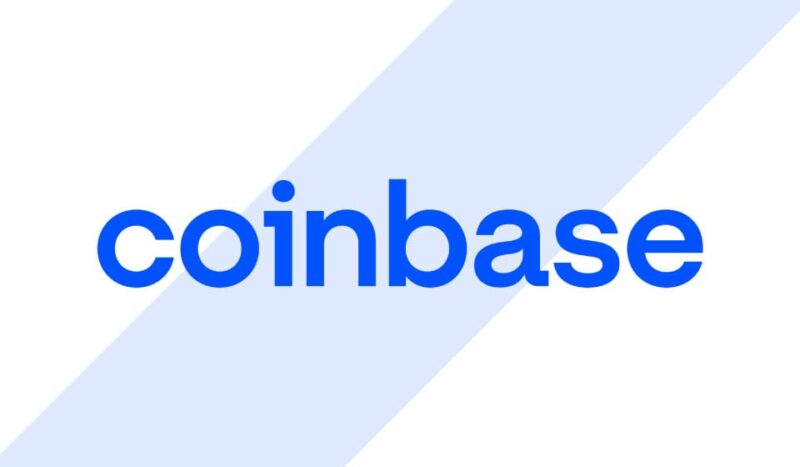Leggi questo articolo in Italiano

Coinbase Wallet: security and stability for your cryptocurrencies
By Gabriele Brambilla
Among the many proposals in the world of crypto wallets, Coinbase Wallet has been able to carve out a leading role by combining security, stability and simplicity
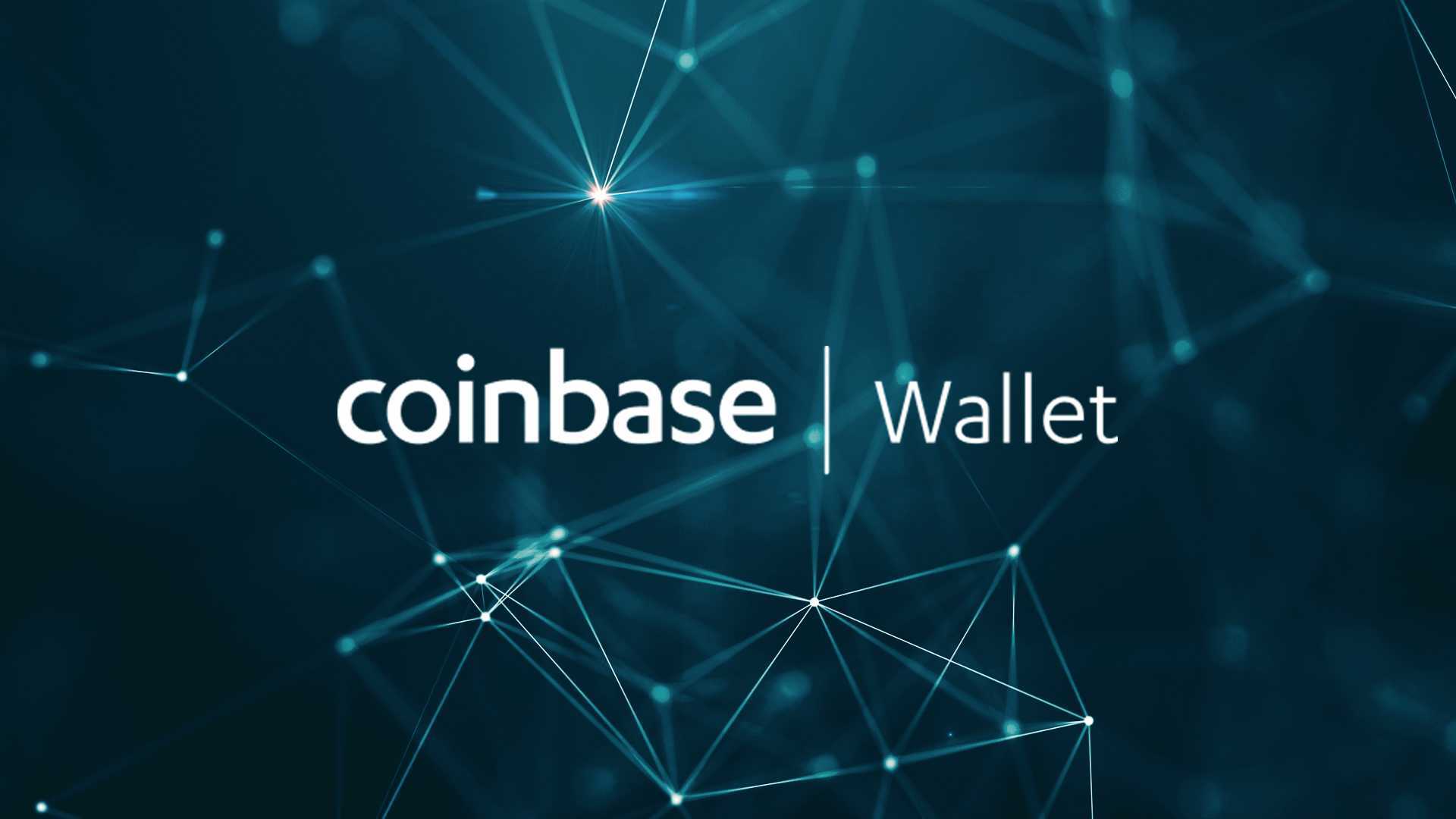
Cryptocurrency wallet: endless choice
Ready to learn more about Coinbase Wallet?
The blockchain and crypto landscape is rich with alternatives. From exchanges to DeFi platforms, similar or very different competitors scramble to grab as many users as possible.
In this scenario, crypto wallets are no different: different types and equally different realities seek to grow and position themselves. Among them, Coinbase Wallet is certainly one of the main ones, either for being the product of one of the most important exchanges or for its excellent features.
We are therefore about to learn more about this application. First we will properly frame it, then we will find out its main features.
We will of course also give space to basic operations, such as creating a new wallet, importing an existing one and crypto transactions.
A tutorial in perfect The Crypto Gateway style: simple but comprehensive.
Index
- What is Coinbase Wallet?
- What is the difference between Coinbase and Coinbase Wallet?
- How does Coinbase Wallet work?
- How do I get Coinbase Wallet?
- How to move cryptocurrencies
- How to connect Coinbase Wallet to a DApp
- Coinbase Wallet Settings
- Is Coinbase Wallet better than MetaMask?
- Coinbase Wallet: a good choice
What is Coinbase Wallet?
Coinbase Wallet is an ideal crypto wallet for the user looking for a comprehensive yet easy-to-use tool. In fact, more advanced software is often complex, requires study and can even give some minor problems. Many people, on the other hand, want something quick and reliable; Coinbase Wallet meets this very need.
What exactly is Coinbase Wallet used for? What are its functions?
This crypto wallet integrates several features that make it a multipurpose tool. Let’s look at them more specifically.
First of all, Coinbase Wallet allows us to send and receive cryptocurrencies via different blockchains. Among the supported networks are Ethereum and Polygon. There is no shortage of Coinbase Bitcoin Wallet, although it is present only in the mobile version.
It is also possible to buy coins and tokens directly from the wallet by taking advantage of Coinbase Pay; the procedure is not difficult and requires a connection to one’s Coinbase account (click on the link to create one).
The software also allows us to hold NFTs so that we have everything in one place.
Also under development are internal DeFi features, for now only available with Ethereum. Basically, by linking our Coinbase account we will be able to invest in decentralized finance through the exchange’s proposition.
True DeFi enthusiasts will want to act without any intermediary, however. Well, there is good news: Coinbase Wallet is supported by several decentralized finance protocols including Curve and AAVE.
Basic social features round out the offering. For example, it is possible to follow a profile matched to a certain address, seeing its activities. Sort of like a social Etherscan to put it that way.
If talking about Coinbase and wallet is confusing you, don’t worry: in the next paragraph we will remove any doubts right away.
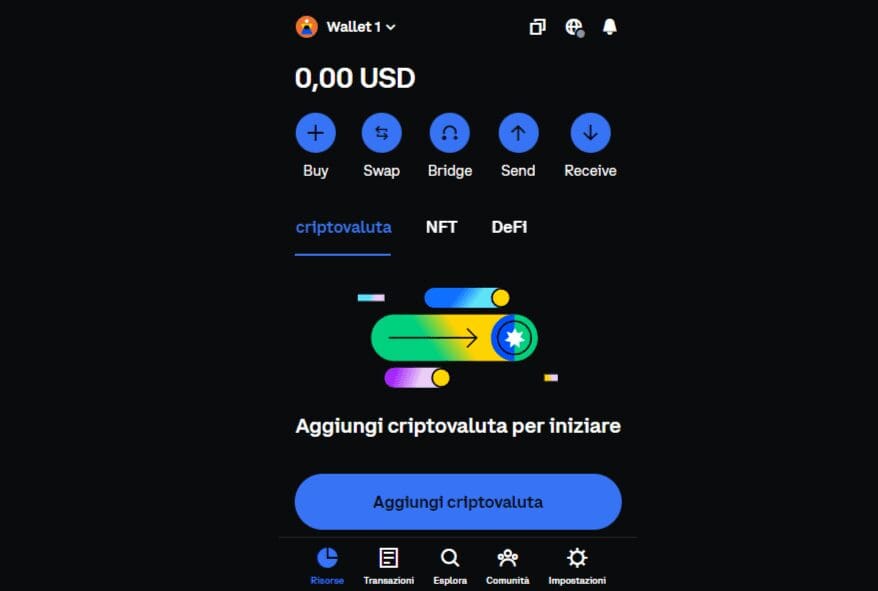
What is the difference between Coinbase and Coinbase Wallet?
Some may ask, “What is the difference between Coinbase Wallet and Coinbase?” Let’s answer that right now!
Coinbase is one of the most well-known cryptocurrency exchanges in the world, founded over 10 years ago in the United States.
It is the first company in the industry to go public, eventually going public on Nasdaq. This makes Coinbase a secure exchange, as it must comply with stringent regulations and publish its financial statements periodically.
Coinbase Wallet is the cryptocurrency wallet developed by the company. It stems from the need to offer its customers a non-custodial alternative while keeping them within the company’s ecosystem.
As we said, the wallet is available both in a mobile version and as a browser extension. Compatible with a variety of applications including decentralized finance.
"Coinbase is one of the most well-known cryptocurrency exchanges in the world; Coinbase Wallet is the crypto wallet developed by the company"
How does Coinbase Wallet work?
The Coinbase crypto wallet works because of the years of development and improvement spent by the team.
It serves both as a wallet for sending and receiving cryptocurrencies and NFTs, and as a means to connect to a variety of decentralized finance platforms, marketplaces and beyond.
User experience is close to that of other similar products, for example, MetaMask and Trust Wallet.
The browser extension is installed quickly and allows you to connect just as quickly to the various portals that support Coinbase Wallet.
The mobile app is well done and plays the same role as its “sister.” Clearly, having the wallet available at all times can be convenient, as long as all the security barriers are raised to ward off problems.
In itself, there is not much to go into regarding operation: everything is at hand and intuitive. In a few minutes we will know our way around, guaranteed.
Let’s take a look at the trickier steps, however, so that we are ready to use Coinbase Wallet. Let’s start with creating a new wallet.
How do I get Coinbase Wallet?
Let’s find out how to create a Coinbase wallet. The procedure is almost identical between versions.
First we install the mobile app or browser extension.
At this point, we select the Create new wallet button to get started.
We approve privacy and create our own username. On the browser extension this last action is not mandatory and can be done later.
Let’s get to the step related to login. The mobile app will ask us whether we would like to use biometric sensors (fingerprint or Face ID) or password. The browser extension will only propose the password. Remember that the password will allow us to access only the device with which we are configuring the wallet.
We choose what we want and proceed further. We recommend marking the password on paper, to be kept in a safe place later.
Here we come to the key step: the seed phrase. Coinbase Wallet will tell us a phrase consisting of 12 words that we must transcribe in the exact order in which they are presented.
The seed phrase is the means to access the wallet from any device: should we lose the password it will be indispensable, as well as if we want to import the wallet elsewhere: only it will be able to allow us to do so. Lose it and we will be in trouble: we will have no way of recovering the funds.
Beware of the bad guys: the seed phrase is the gateway to deposited cryptocurrencies. Never communicate it to anyone, including those posing as customer support.
Next we will have to pass a quick check, just to make sure that the seed phrase has been marked correctly.
With that done, we will have concluded the configuration of our Coinbase Wallet address.
For those interested, let’s also take a look at how to import an existing wallet.
Let’s go back to the beginning, to the first post-installation screen. However, now we will not click on Create new wallet but on I already have a wallet.
We will be able to import Coinbase wallet, MetaMask, Trust Wallet and others. We will only have to indicate the seed phrase of that specific wallet and follow a few steps, nothing more.
How to move cryptocurrencies
Let’s find out how to receive and send coins and tokens with our Coinbase wallet. Spoiler appreciated: smooth and fast practice.
How to receive cryptocurrencies on Coinbase Wallet.
From the main screen of the Coinbase browser extension or app, we click on the Receive button.
We then select the address of our interest, based on the asset we need to receive. For example, ETH may arrive via Ethereum, or we may prefer Polygon.
At this point, we click on one of the two buttons to the right of the designated chain (highlighted in the image). One will have us copy the address so we can forward it to the sender via message or email; the other will instead generate a QR Code that we can scan.
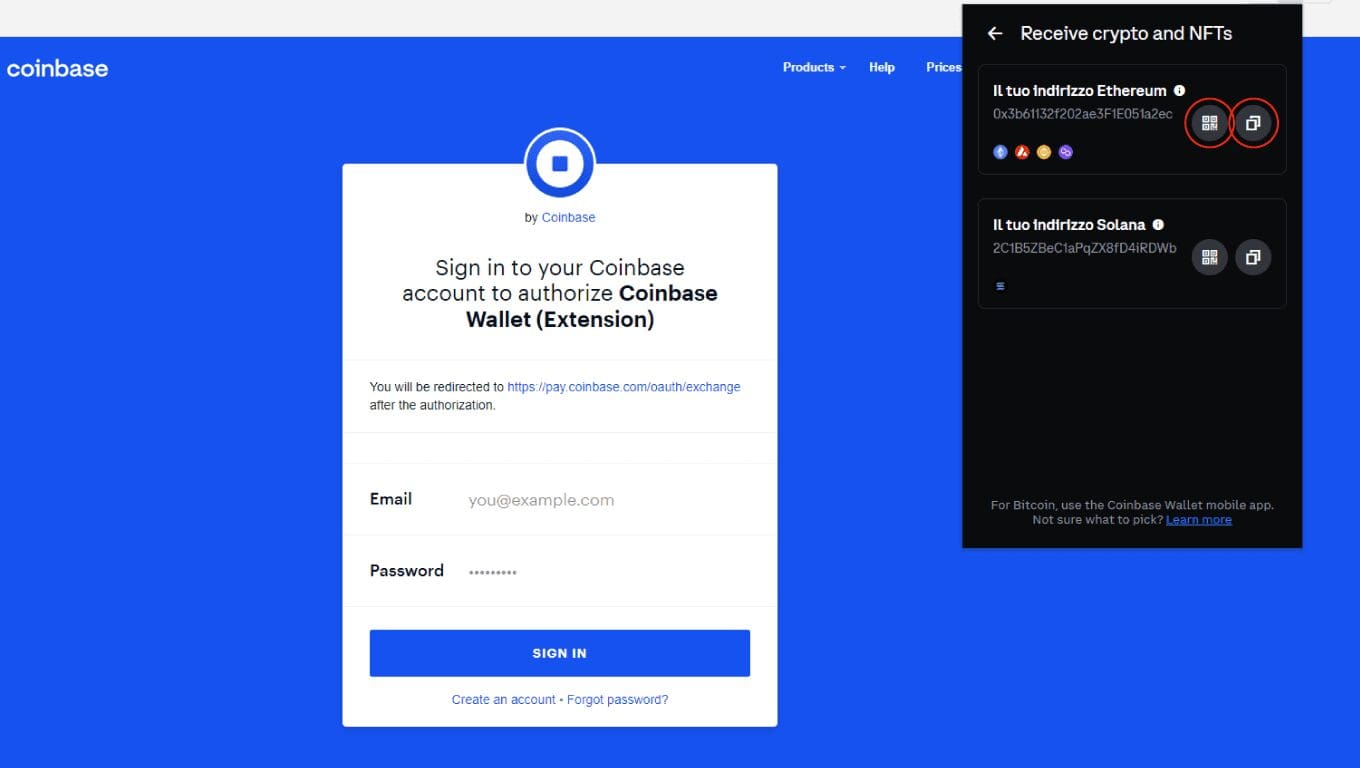
That’s all we’ll have to do: now the crypto sender will have to create the transaction. After that, the funds will arrive on our wallet within a certain time, depending on the congestion of the network as well as the basic speed it has.
How to send cryptocurrencies from Coinbase Wallet
While some additional steps are required, sending cryptocurrencies also brings no complications.
From the main screen, we tap on the Send button. We then follow these steps:
- Indicate which asset we intend to send, as well as the amount. It should clearly not exceed the available balance.
- Enter the recipient’s address. From the application we also have the option of scanning the QR Code by camera.
- Let us carefully review what has been written. This is because transactions on blockchain are irreversible: best to do extra verification before proceeding.
- Confirm to conclude the procedure. In case we have matched a Ledger, we will have to approve the transaction on it in order to continue. Nothing complex, right?
Now that we know how to send and receive crypto on our Coinbase wallet, let’s find out how to connect it to an app.
How to connect Coinbase Wallet to a DApp
The steps to connect a DApp vary depending on the wallet version we are using.
The browser extension is straightforward: we enter the platform and look for the classic button like Connect wallet, Connect or similar. From the list that will appear we will have to search and select Coinbase Wallet. We enter the password and we are ready.
We recommend being sure of the reliability of the DApp before connecting to avoid running into malicious portals.
If we were using the wallet mobile app instead, the procedure changes.
To connect the mobile app we will need to access the platform from a computer or other device. Clicking as seen above on the connect button, we choose Coinbase Wallet.
In addition to the ability to connect with the browser extension we will be offered a QR Code: let’s scan it through the wallet app and we’re done!
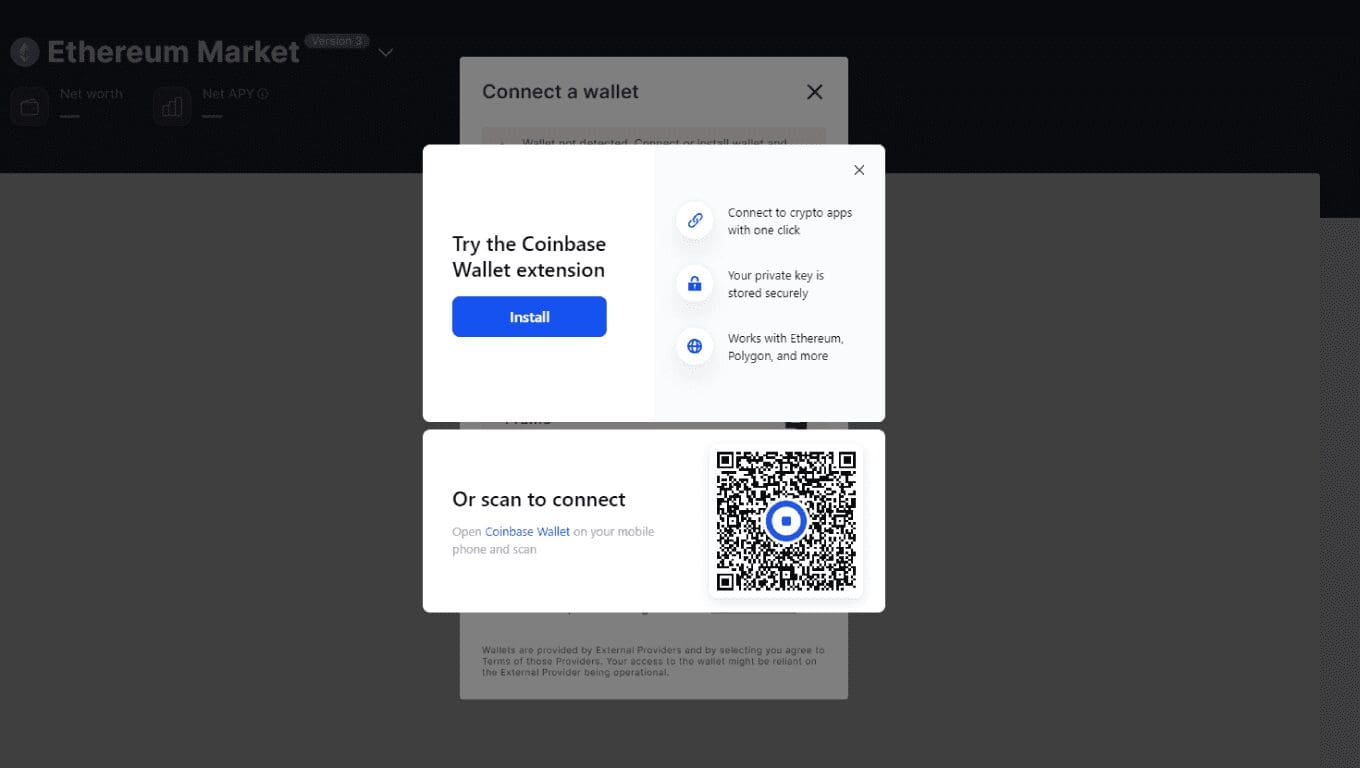
Coinbase Wallet Settings
Quick overview to wallet settings. Both from the app and from the browser extension, they can be reached under Settings. The list is quite substantial, let’s look at it point by point:
- Add and manage wallets: as the name suggests, from here we can edit the various wallet addresses. We will be able to add new ones, import them and remove them.
- Show recovery phrase: did we lose the seed phrase? Bad! Fortunately, through this setting we will have the possibility to recover it, provided we remember the password!
- DApp connection: very useful area from which to manage the applications connected to the wallet. We will be able to monitor and remove them with one click.
- Networks: here are all the blockchains supported by Coinbase Wallet and their specifications. Testnets are also included.
- Settings for developers: section designed for professionals, to be ignored if you don’t have special skills and needs.
- Manage notifications: just like a smartphone, Coinbase Wallet sends notifications after certain operations. From here we can manage the alerts and decide which ones we want to receive.
- Visualization: are you a light or dark theme type? Choose the one you prefer.
- Local currency: set to USD (U.S. dollar) by default, can be changed from this entry.
- Hide assets: in case you wish to hide certain assets, here is the place to proceed.
- Security lock: how much idle time should elapse before the wallet automatically locks? Let’s indicate it here (default value: 24 hours).
- Change password: area where we will be able to change the login password.
- Miscellaneous info: help, terms of service and version of Coinbase Wallet.
Is Coinbase Wallet better than MetaMask?
Usually a non-custodial wallet with browser extension and application is compared with MetaMask, the most popular one ever.
As you know, we do not like to go beyond mere opinions. Therefore, we cannot assign any rating that says which one is the best.
Both wallets are free, reliable, secure, and offered by many applications. They support NFT, coin and token swaps, staking and hardware wallets.
A not insignificant difference lies in the code: MetaMask is open source, while Coinbase Wallet is not. This point might influence the choice but it’s all up to personal judgment.
Also beware of compatibility: Coinbase supports additional networks to MetaMask, such as Bitcoin and Solana.
Therefore, each user will have to decide which is suitable for the use he or she wants to make of it.
Since they are free, we are absolutely free to take advantage of both wallets, depending on the specific use case.
"Coinbase Wallet vs MetaMask: a clash that has no winner!"
Coinbase Wallet: a good choice
When deciding which crypto wallet to use, the many alternatives out there can be confusing.
The choice depends on a variety of factors including security, user experience and personal needs. Coinbase Wallet is certainly a good option, through which you cannot go wrong.
The service is well developed, intuitive and above all non-custodial. After we make the indispensable security arrangements, our coins will be safe from unforeseen and malicious attackers.
What do you think of Coinbase Wallet? Do you use it or do you prefer another cryptocurrency wallet? Leave a comment on our social channels.
